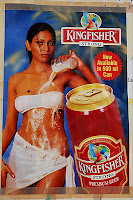The Male Gaze
The male gaze is objectifying of
women. This point of view depicts woman
as ever alluring, speaking predominately (if not only) with her body and
nakedness depicting a message vulnerability, eroticism & availability. What
Laura Mulvey describes as “ in their traditional exhibitionist role women are
simultaneously looked at and displayed, with their appearance coded for strong
visual and erotic impact so that they can be said to connote to-be-looked-at-ness” (Mulvey 837)
The male gaze has extended and
transcended from European paintings to popular media now. The overt and
subliminal message it depicts continues to strip women for male surveying,
trivializing their life potential thus causing a fracture and compartmentalizing
of the female psyche, distorting her feelings of capacity, self worth &
acceptance. In ‘Ways of Seeing,’ John Berger, goes further to say that “ to be
born a woman has been to be born, within an allotted and confined space, into
keeping of men.” (Berger 46) This type of mentality continues to perpetuate
mixed & incorrect messages to men on how to survey and treat women and to
women on what they should expect and what they actually deserve as a basic
human right.
painting by Salvador Dali
I can’t remember the exact momement I had the shift and this awareness, it was some time in high school, but as a result I
kind of freaked out and went through a long phase of some type of androgyny.
Where I did not want my body to be surveyed or on “display” so I began to where
my fathers old clothes. I became more and more conscious of not being able to
identify with teen mags and advertisements that I felt I had reached Mecca when
I discovered alternative outlets for inspiration and support amongst
independent ‘zines’ (magazines) across America. I discovered girls who were on
all on different levels of dealing with the male gaze and message. From girls that were very broken and hurt, to
girls offering alternative messages on self identity and self worth, to girls
offering valuable information on reproductive health & safe sex. In essence
a positive, pro-active network of girls finding and making an alternative to
the “male gaze” imposed on them.
© Carrie Mae Weems
Bell Hooks presents a point of
view as a black woman spectator not being able to identify with the object on
survey of the male gaze, traditionally white women. She explains that originally African
Americans as slaves were denied the ability to look, “ that all attempts to
repress our/black peoples’ right to gaze had produced in us an overwhelming
longing to look, a rebellious desire, an oppsitional gaze.” (Hooks 116) How in
order to for a black woman to identify as a spectator she would have to ignore
the racism to be able to have some type of bond or identification with the
women under survey. This “oppositional gaze” became defiant, non-identifying, questioning
and “on guard”of the typical representation of woman. The work of Carrie Mae
Weems I think is a representation of the "oppositional gaze. "
© Carrie Mae Weems
Berger, John. “Ways
of Seeing”, Penguin,
1972, Pg 46
Hooks, Bell. “The
Oppositional Gaze.” Black Looks: Race and
Representation. Boston: South End
Press, 1992:. Pg 116
Mulvey, Laura. "Visual Pleasure and Narrative
Cinema." Film Theory and Criticism: Introductory Readings. NY:
Oxford UP, 1999: pg 837







I enjoyed your post. I liked the way you wrote about the gaze almost in history kind of way. I'm also glad you found alternative magazines, better to bombarded extra hard by the male gaze =]
ReplyDeleteIt’s sad that this is the reality. Even rereading from your blog post the short part where it mentions “in order for a black woman to identify as a spectator she would have to ignore the racism to be able to have some type of bond or identification…” I love that you put in your own personal identification and that you went through a period where you only wore your dad’s clothing. It’s identifiable in the sense that there were times during the summer where it was humid, extremely so to the point where I would wear a thin tee shirt but would feel self-conscious or on guard after males down the street would whistle. For me, it almost felt as if you were not wearing it for yourself but for them. For them to have that power and control over my appearance was degrading and I did feel objectified. So, it’s a great point that you made in your post.
ReplyDeleteI too, hid in big shirts, and jackets because i didn't want to be objectified. I'm really glad that you talked about how we (girls) process and deal with the male gaze in very different ways. Some can be hurtful, self destroying, or somewhat healthy. I consider myself a "lucky" one, since i had the support of my mother and photography. Although it sounds weird, and sad when you think about how many girls "made it" safe through the teen stage. I agree with you that the problem should be looked at as a HUMAN ISSUE. What kind of society are we if we can't respect our mothers, our sisters, our girl-friends?
ReplyDelete